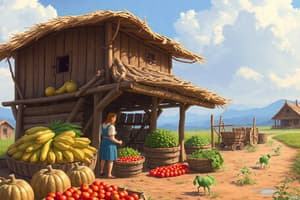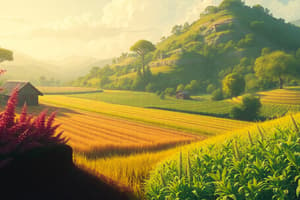Podcast
Questions and Answers
What is one of the main characteristics of conventional agriculture?
What is one of the main characteristics of conventional agriculture?
- Heavy dependence on agribusiness (correct)
- Minimal use of pesticides
- Diverse crop cultivation
- Low capital investments in technology
What is a primary concern regarding the ecological impact of conventional agriculture?
What is a primary concern regarding the ecological impact of conventional agriculture?
- Improvement in soil productivity
- Runoff of fertilizers leading to eutrophication (correct)
- Reduction of ground water pollutants
- Increase in biodiversity
What farming practice contributes to the decline in soil productivity?
What farming practice contributes to the decline in soil productivity?
- Organic farming
- Cover cropping
- Crop rotation
- Soil compaction (correct)
Which of the following is a result of raising a large number of livestock in confined spaces?
Which of the following is a result of raising a large number of livestock in confined spaces?
What percentage of recent increases in food production is attributed to conventional agriculture, according to the World Bank?
What percentage of recent increases in food production is attributed to conventional agriculture, according to the World Bank?
What concept describes the conversion of productive land to desert conditions often caused by overgrazing?
What concept describes the conversion of productive land to desert conditions often caused by overgrazing?
Which of the following best describes monoculture in agriculture?
Which of the following best describes monoculture in agriculture?
What is a direct consequence of pesticide use in conventional agriculture?
What is a direct consequence of pesticide use in conventional agriculture?
What is one significant environmental impact of agricultural practices mentioned?
What is one significant environmental impact of agricultural practices mentioned?
How has urban and suburban sprawl affected farmland?
How has urban and suburban sprawl affected farmland?
What challenge do potential farmers face when entering the agricultural business today?
What challenge do potential farmers face when entering the agricultural business today?
What role do cattle and sheep play in climate change?
What role do cattle and sheep play in climate change?
Which of the following describes a potential health risk linked to farming practices?
Which of the following describes a potential health risk linked to farming practices?
What subjective term is used to describe organisms that cause damage where they are not wanted?
What subjective term is used to describe organisms that cause damage where they are not wanted?
What is a common misconception about the term 'pesticide'?
What is a common misconception about the term 'pesticide'?
Flashcards are hidden until you start studying
Study Notes
Conventional Agriculture
- Conventional agriculture, also known as modern agriculture or industrial farming, has significantly increased food production worldwide.
- The World Bank estimates that 70% to 90% of recent increases in food production are due to conventional agriculture, not larger farmland.
- Conventional farming usually includes large-scale farms, monocultures, high-yield hybrid crops, mechanization, and heavy use of pesticides, fertilizers, and herbicides.
- For livestock, animals are often kept in concentrated, confined spaces.
Ecological Concerns
- Conventional agriculture has negative impacts on soil productivity, including:
- Erosion of topsoil due to wind and water
- Soil compaction
- Loss of soil organic matter
- Decreased water holding capacity
- Reduced biological activity
- Salinization of soils in heavily irrigated areas
- Desertification, caused by overgrazing and other factors, is a growing problem, particularly in some areas of Africa.
- Agricultural practices contribute to non-point source water pollution, including:
- Salts
- Fertilizers (nitrates and phosphorus)
- Pesticides
- Herbicides
- Pesticides from all categories have been found in groundwater and surface water.
- Nutrient runoff leads to eutrophication and "dead zones" in rivers, lakes, and oceans.
- Overuse of water for irrigation without considering natural cycles contributes to water scarcity.
- Resistance to pesticides has developed in over 400 insect and mite pests and over 70 fungal pathogens.
- Pesticides have harmed pollinators and other beneficial insects.
- Habitat loss due to converting wildlands into agricultural fields impacts ecosystems.
- Conventional agriculture contributes to global climate change through:
- Destruction of forests and native vegetation
- Release of carbon dioxide and other greenhouse gases
- Methane production from livestock, especially cattle and sheep.
Economic and Social Concerns
- The U.S. agricultural sector has experienced:
- Increasing federal expenditures
- Growing income disparity among farmers
- Concentration of agribusiness into fewer corporations
- Limited market competition for farmers
- Farmers receiving less of the consumer dollar spent on agricultural products
- Loss of farms, particularly small farms, in recent decades
- Difficulty for potential farmers to enter the business due to high costs
- Loss of farmland to urban and suburban development.
Impacts on Human Health
- Potential health risks associated with farming practices include:
- Drug-resistant bacteria due to antibiotic use in animal production
- Contamination of food and water with pesticides and nitrates
- High risk of pesticide exposure for farm workers.
Philosophical Considerations
- American agriculture has shifted from a largely agrarian society to a culture with few farmers.
- Less than 2% of Americans produce food for the entire U.S. population.
- Questions arise about sustainable and equitable food production, as well as the impact on American values and rural life as farmland ownership declines.
Population Growth and Food Security
- The world population is expected to reach 9.7 billion in 2050 and 11.2 billion by 2100.
- Population growth is particularly high in developing countries.
- Food security is a major concern in developing countries, driven by factors such as rapid industrialization, poverty, political instability, food imports, and debt burdens.
Pests and Pesticides
- Pests are organisms that cause damage to crops, humans, or animals.
- Pesticides include substances used to control pests, including insecticides, herbicides, and fungicides.
- Most pesticides pose some risk of harm to humans, animals, and the environment.
- While posing risks, pesticides are also useful for controlling disease-causing organisms and pests.
Studying That Suits You
Use AI to generate personalized quizzes and flashcards to suit your learning preferences.




